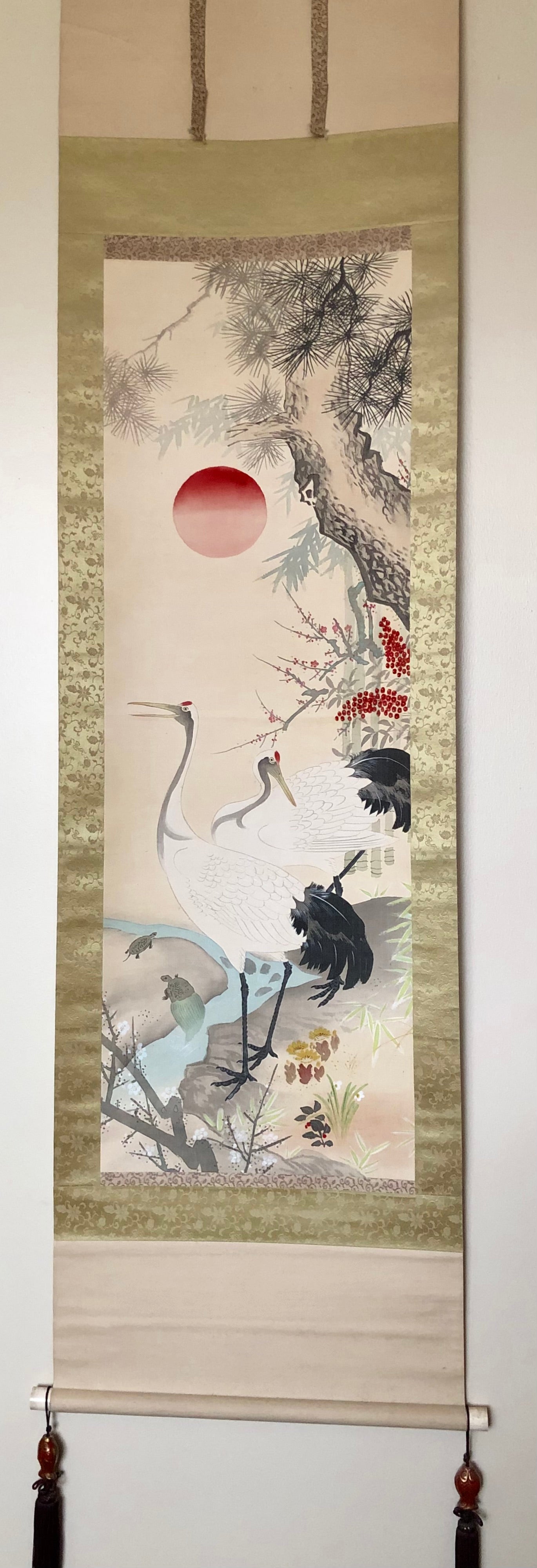



Antique Japanese Kakejiku: “Tsuru Kame | Crane and Turtle” by Nadafune Ono
Dimensions: 79-0”l x 21-0”w
Offered is an authentic work of art that stimulates the viewer and encourages cultural understanding.‘Tsuru kame’ is the quintessential auspicious Kakejiku displayable for almost all of the scenes of celebration. They have been a symbol of longevity and there is even a saying ‘Cranes live for a thousand years, turtles live for ten thousand years.’ in Japan. According to one theory, it is because the crane and turtle were considered vehicles of hermits for flying and cruising underwater in ancient China. The vehicles were thought to have a long life undoubtedly for hermits who are meant to be immortal. Another reason why the crane and the turtle are thought to be auspicious is for the crane, their habit of being monogamous and staying with the same partner for life as that is seen as the ideal style of a married couple. As for the turtle, they were believed to be Genbu, one of the four Gods, in disguise in ancient China.
The Crane, along with the turtle and the pine tree, is one of three frequently used images to convey the wish for longevity. The turtle (Kani) is usually pictured with a long hairy tail and is called a minogame, meaning a turtle wearing a straw raincoat. Over many years spent in water, bluish-green algae attaches and thrives on the turtle’s carapace, growing long and luxurious, and giving the appearance of a hairy tail. The years it takes for the algae to lengthen reveal the turtle’s long life.
As for the Sacred Pine Tree, In Japanese culture, the pine tree represents longevity, good fortune, and steadfastness. It is commonly linked with virtue and long life, immortality, and a symbol of rebirth, renewal, and a bright (hopeful) future. Reverence for trees has long had a place in the Shinto religion, which originated in Japan, holds that spirits inhabit trees that reach the age of one hundred years. These spirits, known as Kodama, develop into the personality of the tree.
The hanging scroll being offered has all of its parts intact including the decorative fabric straps called tare-fuutai or sage-fuutai made to appear as an integral part of the top of the hanging scroll. The flat wooden bar at the top is covered in silk (stave); and the bottom round bar, (jiku) is also covered in silk and capped with bone, has the two original ceramic fish scroll weights with tassels and Kirkwood box are included in this offer.
Condition: Excellent meaning that the piece retains its original craft/workmanship showing a wonderful-developed patina commensurate which suggests a degree of wear that corresponds to its vintage and is void of damage, cracks, or repairs and meets all the standards of the collectible Kankijiku.
